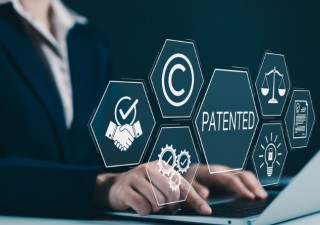Intellectual property on the high seas
31 May 2023

Where the maritime field and intellectual property are concerned, the waters can be a bit rough.—Espie Angelica A. de Leon
The maritime industry is seeing a wave of innovation activities – at least in some jurisdictions, such as the United States. In the U.S., not only is maritime technology rapidly growing amid the current digitization and digitalization, but it is also an area of focus, causing not trickles but spurts of R&D initiatives.
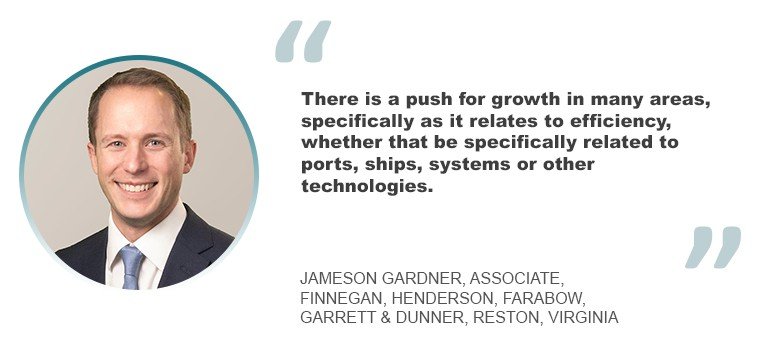
“There is a push for growth in many areas, specifically as it relates to efficiency, whether that be specifically related to ports, ships, systems or other technologies,” said Jameson Gardner, an associate at Finnegan, Henderson, Farabow, Garrett & Dunner in Reston, Virginia, a suburb of Washington.
R&D is taking place in a wide range of areas, from ship fuel efficiency improvement and the development of AI for autonomous control of ships and ship operations or systems to the use of AR/VR and robotics for shipbuilding and repairs and the use of machine learning to improve the efficiency of operations. This includes fleet management, shipping routes, cargo planning and tracking, crew planning, port coordination and others.
Certain technologies, particularly underwater sound abatement and underwater videography, are research-intensive.

However, in certain parts of Asia, such as Bangladesh, the opposite is taking place. Mohammed Forrukh Rahman, head of chambers and divisional head at Rahman’s Chambers in Dhaka, revealed that the country is not yet technologically developed enough in the marine sector, and part of their maritime industry still runs with the traditional system.
He said: “For example, the fishing system follows the traditional way by using the local gear motorized and non-motorized boats. Though there are many kinds of technological gadgets in existence, there is not much research or innovation in Bangladesh.”
Rough sailing the maritime industry, IP and international trade
While these exciting developments – at least those outside Bangladesh – offer great news, it hasn’t been smooth sailing for the maritime industry. Predictably, challenges are not far behind. Where the maritime field and intellectual property are concerned, the waters can be rough.
According to John Mulcahy, a partner at Finnegan in Reston, enforcement will always be an issue as certain geographical constraints are involved.
Geographical extent identifies the area within which IP rights holders may exercise their rights.
“Patent rights have geographical limitations, and it gives protection in the national territory. A patent owner has the legal authority to forbid an unauthorized party from creating, proposing to make, disposing of, using, importing, or retaining a patented product, according to the law,” said Rahman.
Gardner cited the 1982 UN Convention on the Law of the Sea, noting that it dictates that a country with a coastline has territorial waters usually stretching approximately 12 nautical miles out to sea. These are generally the limits for the enforcement of patent rights.
“While a nation may be able to enforce patent rights within its territorial waters, there are questions to enforceability beyond territorial waters,” he explained. “Further, the Paris Convention provides that where the patent relates to the ‘needs’ of the ship – i.e., not merely cargo – a patent in a member country cannot be enforced against a visiting ship belonging to another member country when that ship is in international transport.”
The objective, he said, is to avoid territorial patent rights from interfering with international trade.
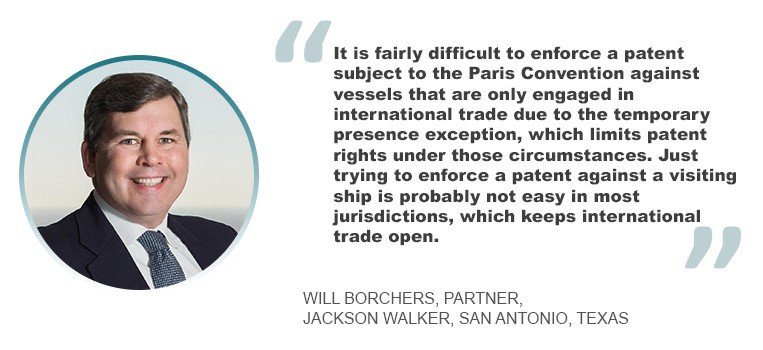
“It is fairly difficult to enforce a patent subject to the Paris Convention against vessels that are only engaged in international trade due to the temporary presence exception, which limits patent rights under those circumstances. Thus, just trying to enforce a patent against a visiting ship is probably not easy in most jurisdictions, which keeps international trade open,” said Will Borchers, a partner at Jackson Walker in San Antonio, Texas.
Thus, it is crucial to have patent rights in other countries.
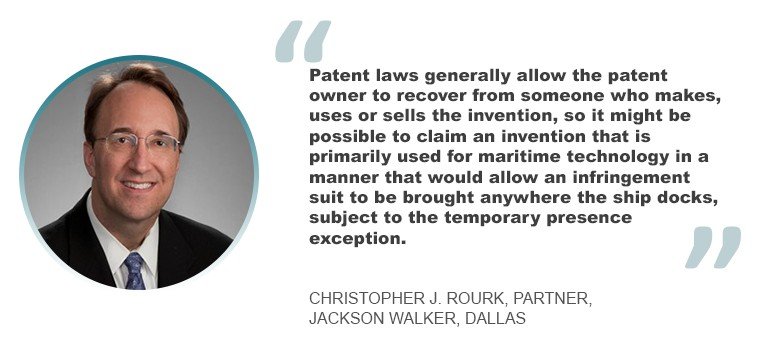
“In general, you have to look at the potential markets for a product, where a product is used, and where it might be manufactured to determine whether the geographical extent to IP rights is important to a specific maritime technology,” said Christopher J. Rourk, a partner at Jackson Walker in Dallas.
By GDP, the three largest markets are the U.S., China and Europe. Rourk emphasized that one must consider the potential recovery for infringement when deciding whether to seek IP protection. This is because some jurisdictions will not award much in the way of damages and might only issue an injunction that could be easy to avoid, such as if the infringer can easily set up shop across the street and continue to infringe.
Meanwhile, an injunction might be an adequate remedy in the case of the shipbuilding industry since it is not easy to relocate facilities. China, South Korea and Japan are the three biggest shipbuilding countries in the world.
“Patent laws generally allow the patent owner to recover from someone who makes, uses or sells the invention, so it might be possible to claim an invention that is primarily used for maritime technology in a manner that would allow an infringement suit to be brought anywhere the ship docks, subject to the temporary presence exception,” said Rourk.
Borchers shared that inventors may also create items that can be used in maintaining and reconditioning ships, where the inventions could be used in a large number of countries.

“Likewise, inventions used only in international waters, such as building, mapping, and repairing underwater pipelines and cables, could also be made in numerous countries,” added Arthur Gollwitzer, a partner at Jackson Walker in Austin, Texas.
According to Rourk, pursuing IP rights for these inventions in many countries might make sense, but he stressed that a cost-benefit analysis should first be undertaken. Doing so will help determine whether the cost of obtaining and enforcing patent rights would be less than the expected recovery, or benefit from obtaining an injunction.
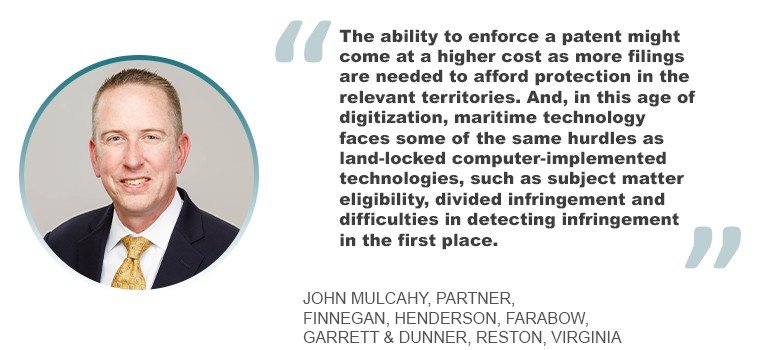
“Consequently, the ability to enforce a patent might come at a higher cost as more filings are needed to afford protection in the relevant territories. And, in this age of digitization, maritime technology faces some of the same hurdles as land-locked computer-implemented technologies, such as subject matter eligibility – 35 U.S.C. § 101 in the U.S. – divided infringement and difficulties in detecting infringement in the first place,” explained Mulcahy.
He continued: “These last two are particularly acute in the maritime industry, where the infringing technology may be mobile, and infringement may be conducted across borders. For example, the steps of a method claim or the parts of a system claim may be divided among several locations, and/or several entities and the details of the infringing technology may be hidden behind a digital firewall.”
Rahman agreed.In the era of digitalization, infringement is too easy, he said. To prevent unauthorized use of a patented product on a ship can be even more challenging, due to the temporary presence exception. Online IP infringement is rapidly increasing at sea for many reasons. Also, online IP infringement has no geographical boundaries.
He related that Bangladesh has no concept of geographical patents yet.
“If a particular country’s patentee wants protection in Bangladesh on his invention, then he or she needs to file for a patent. If a foreign vessel using an infringed product comes to India temporarily or accidentally, the patent right will not be infringed, subject to some exceptions. However, a similar law is not available for Bangladesh,” shared Rahman.
According to Rourk, however, there are several other factors affecting international trade. IP protection of inventions for maritime purposes will not significantly impact it by itself. He added that a developer of IP would usually not be concerned about how protecting his inventions affect international trade.
“It is certainly possible that an IP owner could assert IP rights in a manner that has some incremental impact on international trade, but if an innovation is that valuable to international trade, then it is probably worth the cost of developing an alternative or obtaining a license,” said Rourk. “It is also noted that any new innovation will not prevent the existing fleets of vessels from being used as they currently exist, and it is doubtful that an innovation could significantly impact the commercial viability of such existing vessels.”
On the other hand, IP protection of copyrightable works could compromise international trade. An example of such a case involves a country where copyrightable works are not protected, forcing other countries to impose trade barriers between them.
Steering through the rough waters
To protect the IP of inventions used at sea without compromising international trade, Mulcahy said the first step is to take advantage of the Patent Cooperation Treaty system and the ability to file for a patent in 151 countries with a single international patent application.
Another step is to protect IP using trademarks, copyrights and trade secrets. Commercial agreements can also be useful.
“For example, a company could refuse to do business with another company if it will not agree to respect its IP rights in all markets even if it only has IP protection in a few key markets, and could charge more for companies that will not agree to implement IP protections, or could otherwise limit access to those markets where it has IP protection to reduce the commercial viability of unlicensed products,” said Rourk.
However, the commercial agreement has to be reviewed to ensure it complies with laws that prevent anticompetitive practices.
For Rahman, laws and rules regulating IP rights and their enforcement must be more harmonized and easier to understand, thus bringing about clearer results.
Navigating the sea of IP, maritime industry and international trade may be rough – but the waters can be less turbulent if the ship is steered with a firm grip and on the right course by taking the necessary measures. In the end, the maritime industry might even see a stronger gush of innovation efforts.




